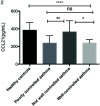Association of serum chemokine ligand 21 levels with asthma control in adults
- PMID: 33503170
- PMCID: PMC7798131
- DOI: 10.6061/clinics/2021/e1713
Association of serum chemokine ligand 21 levels with asthma control in adults
Abstract
Objectives: The chemokine ligand (CCL) 21 regulates the maturation, migration, and function of dendritic cells, and has been implicated in the pathogenesis of asthma. This study aimed to investigate the association between serum CCL21 levels and asthma control.
Methods: The serum levels of CCL21 and other inflammatory cytokines were analyzed in patients with asthma (n=44) and healthy controls (n=35) by enzyme-linked immunosorbent assay. IgE levels and eosinophil counts were determined by turbidimetric inhibition immunoassay and fully automatic blood analysis, respectively. The Asthma Control Test (ACT) questionnaire was used, and spirometry and fractional exhaled nitric oxide (FENO) measurements were performed. A multiple unpaired Student's t-test was performed to analyze the differences in CCL21 and interleukin levels between patients with asthma and healthy controls. The correlation of CCL21 levels with disease severity was evaluated using the Pearson's rank correlation test.
Results: Serum CCL21 levels were lower in patients with asthma (254.78±95.66 pg/mL) than in healthy controls (382.95±87.77 pg/mL) (p<0.001). Patients with asthma had significantly higher levels of IL-1β (19.74±16.77 vs. 2.63±5.22 pg/mL), IL-6 (7.55±8.65 vs. 2.37±2.47 pg/mL), and tumor necrosis factor-α (12.70±12.03 vs. 4.82±3.97 pg/mL) compared with the controls. CCL21 levels were positively correlated with the ACT score (rs=0.1653, p=0.0062), forced expiratory volume in 1s (FEV1)/forced vital capacity (rs=0.3607, p<0.0001), and FEV1 (rs=0.2753, p=0.0003), and negatively correlated with FENO (rs=0.1060, p=0.0310). CCL21 levels were negatively correlated with serum IgE levels (rs=0.1114, p=0.0268) and eosinophil counts (rs=0.3476, p<0.0001).
Conclusions: Serum CCL21 levels may be a new biomarker for assessing asthma control.
Conflict of interest statement
No potential conflict of interest was reported.
Figures




Similar articles
-
Comparison of Fractional Exhaled Nitric Oxide in Elderly Patients with Asthma-chronic Obstructive Pulmonary Disease Overlap and Other Airway Inflammatory Diseases.Iran J Allergy Asthma Immunol. 2018 Jun;17(3):232-239. Iran J Allergy Asthma Immunol. 2018. PMID: 29908540
-
Exhaled nitric oxide for monitoring childhood asthma inflammation compared to sputum analysis, serum interleukins and pulmonary function.Pediatr Pulmonol. 2008 Feb;43(2):134-41. doi: 10.1002/ppul.20747. Pediatr Pulmonol. 2008. PMID: 18085692
-
Increased IL-17A secreting CD4+ T cells, serum IL-17 levels and exhaled nitric oxide are correlated with childhood asthma severity.Clin Exp Allergy. 2013 Sep;43(9):1018-26. doi: 10.1111/cea.12119. Clin Exp Allergy. 2013. PMID: 23957337
-
Correlation Between Fractional Exhaled Nitric Oxide Levels and Efficacy of Inhaled Corticosteroids in Children With Bronchial Asthma.Am J Ther. 2018 Nov/Dec;25(6):e617-e625. doi: 10.1097/MJT.0000000000000423. Am J Ther. 2018. PMID: 26990963 Clinical Trial.
-
ASSOCIATION BETWEEN FRACTION OF EXHALED NITRIC OXIDE AND SPIROMETRY DATA AND CLINICAL CONTROL OF ASTHMA IN CHILDREN AND ADOLESCENTS.Rev Paul Pediatr. 2018 Jan 15;36(1):8. doi: 10.1590/1984-0462/;2018;36;1;00015. Print 2018 Jan-Mar. Rev Paul Pediatr. 2018. PMID: 29412429 Free PMC article. Review.
References
Publication types
MeSH terms
Substances
LinkOut - more resources
Full Text Sources
Other Literature Sources
Medical

